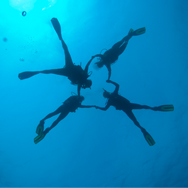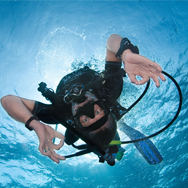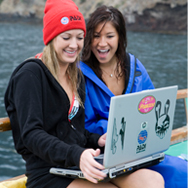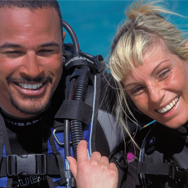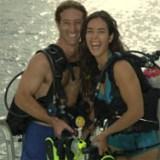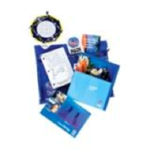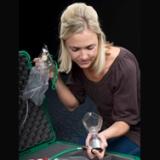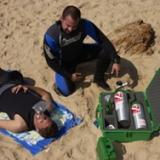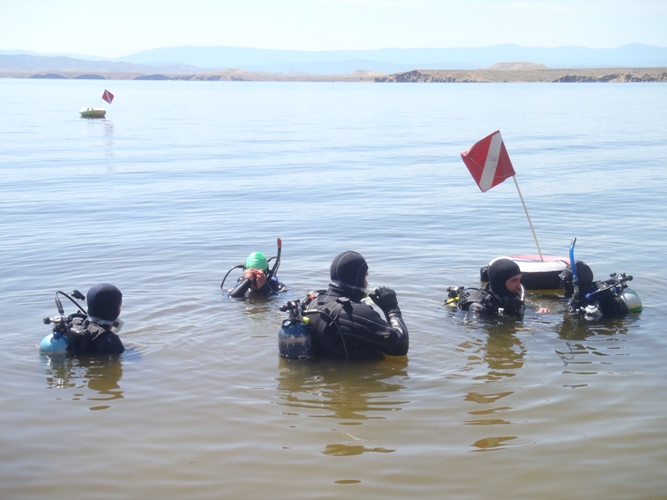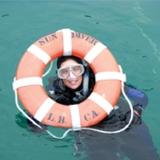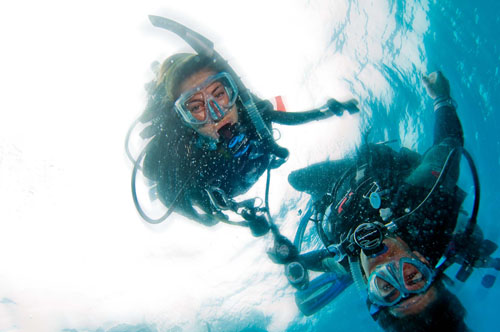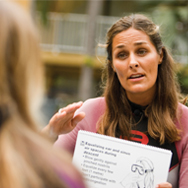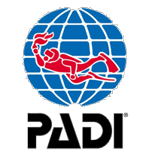 |
I Want to Get StartedDiscover ScubaPADI Discover Scuba® Diving Experience Have you ever wondered what it’s like to breathe underwater. If you want to find out but aren’t quite ready to take the plunge into a certification course, Discover Scuba Diving will let you try scuba to see if you like it. Most PADI dive shops offer a version of this program, either in a pool or other body of water. You might try it close to home or while you’re on vacation.
The Fun Part There is nothing like breathing underwater for the very first time. It takes a little getting used to –after all, human beings weren’t designed to do that – but after a few minutes of awestruck wonder, most participants realize how easy scuba diving really is. The biggest challenge instructors have with the Discover Scuba Diving program is not coaxing participants into the water, but coaxing them out when the program is over. The fun part? It’s all fun!
What You Learn You learn the basics you need to dive under the direct supervision of a PADI Professional. One thing you’ll learn is that you really can breathe underwater and whether you like doing that or not. You will:
The Scuba Gear You Use All the equipment you will need is typically included in a Discover Scuba Diving experience. You’ll use all the basic scuba gear including a mask , snorkel and fins, a buoyancy compensating jacket that also carries your scuba tank, a scuba regulator to breathe from and instrumentation to monitor depth and air supply. You might also wear a scuba wetsuit or a weight system depending on where you do your Discover Scuba Diving program. The Learning Materials You Need Just your willingness and undivided attention Prerequisites To take Discover Scuba Diving, you must be at least 10 years old. Your Next Adventure Once you complete a Discover Scuba Diving program, you’ll want to check out: Scuba DiverWho should take this course? The PADI Scuba Diver course is a subset of the PADI Open Water Diver course. If you’re short on time but really want to become a diver, the PADI Scuba Diver rating might be right for you ? particularly if you expect to go scuba diving primarily with a dive guide. This course is an intermediate step for earning an Open Water Diver certification, if that’s your ultimate goal.
To enroll in a PADI Scuba Diver course (or Junior Scuba Diver course), you must be 10 years old or older. You need adequate swimming skills and need to be in good physical health. No prior experience with scuba diving is required, but you can try it first through the Discover Scuba Diving program.
What will you learn? The PADI Scuba Diver course consists of three main phases:
Get started by registering for Open Water Diver Online – PADI’s eLearning option. The web-based system gives you the background information you need to dive safely and allows you to study at your own pace through an easy-to-use, interactive program. You only need to complete the first three sections, but have a year to complete the whole program if you choose to go on to earn your PADI Open Water Diver certification. There are other home-study materials you can choose from including the Open Water Diver TouchTM (a tablet app) and the Open Water Diver Manual and Open Water Diver Video (a book and DVD package). Stop by your local PADI dive shop to enroll in the course, get your materials and start reading the book and watching the video. Your PADI Instructor will meet with you to schedule knowledge review sessions, confined water and open water dives. What scuba gear will you use? You learn to use basic scuba gear, including a mask, snorkel, fins, regulator, buoyancy control device and a tank. The equipment you wear varies, depending upon whether you’re diving in tropical, temperate or cold water. Your PADI Instructor will explain the equipment you need and may suggest additional educational materials, such as the required logbook. Open Water DiverGet Certified! Take a Scuba Lesson with the PADI Open Water Diver Course Get your PADI scuba certification. If you’ve always wanted to learn how to scuba dive, discover new adventures or simply see the wondrous world beneath the waves, this is where it starts. The PADI Open Water Diver course is the world’s most popular scuba course, and has introduced millions of people to the adventurous diving lifestyle. Start your scuba certification online.
What You Learn The PADI Open Water Diver course consists of three main phases:
Prerequisites To enroll in the PADI Open Diver course or Junior Open Water Diver course, you must
The Fun Part The fun part about this course is . . . well, just about all of it because learning to dive is incredible. You breathe underwater for the first time (something you’ll never forget) and learn what you need to know to become a certified diver. During the course, you’ll make at least five pool dives and four dives at local dive sites under the supervision of your PADI Instructor. Get College Credit You may be able to earn college credit for the PADI Open Water Diver course!
The Scuba Gear You Use In the PADI Open Water Diver course, you learn to use basic scuba gear including a dive computer, and standard accessories. The equipment you wear varies somewhat, depending upon whether you’re diving in tropical, temperate or cold water The Learning Materials You Need PADI offers a variety of home-study materials for the Open Water Diver course. While eLearning is the most convenient option, you may also chose a book and DVD package or a multimedia DVD-ROM. PADI’s Open Water Diver materials cover what you need to know about basic scuba diving skills, terminology and safety procedures. For each concept you’ll read a description and watch a video demonstration. Then you’ll jump in the pool (or pool-like environment) to practice these skills with your instructor. Later, as a certified diver, use the course materials as a reference guide for future diving adventures and to review what you learned. Note: Enroll in the PADI Open Water Diver Course Online for immediate computer-based access to the manual and video integrated into seamless, guided online learning. Start Now You don’t have to wait to get going. With PADI eLearning and the PADI Open Water Diver Course Online, you can start right now. The PADI Open Water Diver Course Online lets you learn the background information you need before each dive at your own pace through friendly, interactive learning. It even helps you choose the PADI dive shop where you’ll make those dives. Skin DiverWho should take this course? Skin diving is snorkeling while making breath-hold dives to observe aquatic life, up close and personal. It’s a great way to explore the underwater world when you’re not able to scuba dive or if scuba diving just isn’t your thing. The PADI Skin Diver course teaches you how to enjoy watching life below the surface and comfortably venture underwater for short visits, whether you dive in a local freshwater lake or the big blue ocean, at home or on holiday at a dive destination. To enroll in a PADI Skin Diver course, you must be at least 8 years old. You need adequate swimming skills and comfort in the water. No prior experience is required.
What will you learn? The PADI Skin Diver course teaches you about:
How can you start learning now?
Enroll in a course at your local PADI Dive Center or Resort, and get started earning your PADI Skin Diver certification. Ask your instructor about the PADI Discover the Underwater World video and companion piece – The Snorkeler’s Field Guide. Although not required for the course, the video has great tips that will come in handy when you hit the water and the field guide covers different underwater environments along with common aquatic life. What gear will you use? The PADI Skin Diver course teaches you how to use basic snorkeling equipment including a mask, snorkel, fins, snorkeling vest, exposure protection like a wet suit and dive weights as needed. Next Step Try scuba diving with the Discover Scuba Diving program I am Already Certified and Ready to Try New ThingsScuba Tune-upThe PADI Scuba Review Course Has it been a while since you’ve been scuba diving? Do you feel like your scuba skills and knowledge are a bit rusty? The Scuba Review Tune-up is just the refresher you need. It reacquaints you with diving so that you're back to feeling comfortable in the underwater world in less than a day.
The Fun Part Brush up on your scuba knowledge and skills. Improve your diving ability, and get your scuba gear ready for your next scuba vacation or diving holiday. What You Learn You go over scuba knowledge you learned during your initial training. Then, practice fundamental skills in a pool or a confined water area. You review:
The Scuba Review course is particularly beneficial if you:
The Learning Materials You Need Quickly and effectively review scuba diving fundamentals with PADI’s Scuba Tune-Up Guidebook. Begin by answering a few questions related to dive safety, problem management and dive planning. For example:
Correct answers will allow you to complete the book quickly. For incorrect answers, you’ll read a brief explanation to help you understand the concept. Prerequisites To take Scuba Review, you must
Adventure DiverThe PADI Adventure Diver Course The PADI Adventure Diver course helps you get more out of diving by introducing you to new types of scuba diving adventures. It’s a great opportunity to work with your instructor to build your scuba diving skills and gain more confidence.
The Fun Part Have you always wanted to try digital underwater photography? How about wreck diving? Here's your chance because you can sample three dives of your choice, get a taste of what you like, and feel more at ease in the water, strengthening your underwater skills and letting you enjoy scuba diving more than ever.
What You Learn You can choose what you’re most interested in learning. Need to work on your buoyancy skills? Try the Peak Performance Buoyancy Adventure Dive. Want to know what you’re looking at down there? Try the AWARE-Fish Identification Adventure Dive. Choose any three of the following Adventure Dives: Adventure Dives available to scuba divers 10 years old and older:
Additional Adventure Dives available to scuba divers 12 years old and older:
The Scuba Gear You Use You use all your basic scuba gear including your underwater compass. Depending on which three adventure dives you pick, you may also try out underwater photography equipment, DPVs (underwater scooters), a dive light, a dry suit, lift bags, a dive flag/float or other specialty gear.
The Learning Materials You Need PADI’s Adventures in Diving Manual and video on DVD provide information on more than 16 types of specialty diving. You’ll use them as a guidebook to improve your diving skills and prepare for new experiences and adventures. Prerequisites To take the Adventure Diver course, you must be
Your Next Adventure After your PADI Adventure Diver certification you can take the next step by completing two more adventure dives. If you've completed five total adventure dives that include deep and navigation, you're a PADI Advanced Open Water Diver. PADI Adventure Dives can also count towards PADI Specialty Diver certifications. For example, if you liked your Night Adventure Dive so much that you wanted to take a complete PADI Night Diver Specialty course, your Night Adventure Dive can count as the first dive of that specialty. Advanced Open WaterPADI Advanced Open Water Diver Course Exploration, Excitement, Experiences. They’re what the PADI Advanced Open Water Diver course is all about. And no, you don’t have to be “advanced” to take it – it’s designed so you can go straight into it after the PADI Open Water Diver course. The Advanced Open Water Diver course helps you increase your confidence and build your scuba skills so you can become more comfortable in the water. This is a great way to get more dives under your belt while continuing to learn under the supervision of your PADI Instructor. This course builds on what you’ve learned and develops new capabilities by introducing you to new activities and new ways to have fun scuba diving.
You’ll hone your skills by completing five adventure dives that introduce you to:
The Fun Part: Your Choice One reason you’ll love the Advanced Open Water Diver course is that you and your instructor choose from 15 types of Adventure Dives to complete your course. You can try your hand at digital underwater photography, wreck diving, diving with underwater scooters, peak performance buoyancy and much more.
Prerequisites To take this course, you must be:
What You Learn The knowledge and skills you get in the Advanced Open Water Diver course vary with your interest and the adventures you have, but include
Get College Credit You may be able to earn college credit for the PADI Advanced Open Water Diver Course The Scuba Gear You Use You use all the basic scuba gear including your underwater compass. Depending on which three adventure dives you pick, you may also try out underwater photography equipment , DPVs (underwater scooters), a dive light a dry suit, lift bags, a dive flag/float or other specialty gear. Check with your local dive shop about gear rentals and packages offered with this course. You can find most everything at the scuba diving shop. The Learning Materials You Need PADI’s Adventures in Diving Manual and DVD provide information on more than 16 types of specialty diving.You’ll use them as a guidebook to improve your diving skills and prepare for new experiences and adventures. Curious about night diving? Flip to the night diving chapter. Once you’ve previewed the skills, your instructor will guide you on your first night diving adventure. Having trouble with underwater navigation? Review the underwater navigation section then sign up for the Navgation Adventure Dive with your PADI Instructor. Your Next Adventure After you’ve tried a specialty in the Advanced Open Water Diver course, you’ll probably want to take the whole course and learn more:altitude diving, AWARE-fish identification, boat diving, deep diving, diver propulsion vehicle use, drift diving, dry suit diving, multilevel and computer diving, night diving, peak performance buoyancy, search and recovery, underwater nature study, underwater navigation, underwater photography, underwater videography, wreck diving . Specialty CoursesAtlitude DiverThe PADI Altitude Diver Course Any time you’re diving at 300 to 3000 metres/1000 to 10,000 feet above sea level, you're altitude diving. If you want to explore the hidden world of a mountain lake, the PADI Altitude Diver Specialty course is for you. The Fun Part Dive more challenging dive sites while you satisfy your curiosity for “I wonder what’s down there?” The fun part about altitude diving is that you can explore places many people have never seen.
What You Learn You’ll learn the effects of pressure at higher altitudes and how to adjust your dive plan accordingly. Whether you use a recreational dive planner table (RDPTM), an electronic eRDPTM or a dive computer, you’ll learn how plan and make a dive at high altitudes. You’ll learn :
To purchase learning materials and equipment, contact your local PADI dive shop or resort. Your Next Adventure Chances are if you’re scuba diving up high in the mountains you may also want to be prepared with the Dry Suit Diver and Ice Diver courses. O2 ProviderThe PADI Emergency Oxygen Provider Course Be the one ready to help a fellow diver should the need arise by becoming a PADI Emergency Oxygen Provider. The Fun Part Breathe easy—knowing that you know how to recognize illnesses treatable by emergency oxygen. Being the best buddy you can be means being prepared – especially in a time of need.
What You Learn You learn how to
The Scuba Gear You Use Scuba gear is not necessary to take this course. The Learning Materials You Need The PADI Emergency Oxygen Provider Manual is an important component of PADI’s Emergency Oxygen training program. Before class, you’ll review a step-by-step explanation of when and how to provide emergency oxygen. You’ll also learn about safety considerations, and how to assemble and disassemble emergency oxygen equipment. The care-at-a-glance card is a quick reference guide to pack in your gear bag and review in case of an emergency.
Prerequisites Though suited for divers, this course has no prerequisites and doesn’t include dives, which means it is equally applicable to those who are around divers – boat crew, non-diving buddies, lifeguards, and shore staff. You don’t need any previous CPR or first aid training to take the course. Your Next Adventure The Emergency First Response certification, which covers CPR and first aid, pairs perfectly with the Emergency Oxygen Provider course. You’ll also want to be sure to complete your Rescue Diver and Master Scuba Diver rating to be the best prepared dive buddy around. PADI AwareWho should take this course? Project AWARE’s philosophy is to mobilize a global force of scuba divers and water enthusiasts who care about protecting the world’s water resources and choose to make a difference – one dive at a time. By earning the Project AWARE Specialist certification, you’ll be aware of the most pressing problems facing vulnerable aquatic environments and know what everyday actions you can take to help protect them.
Anyone who has an interest in the aquatic world should take this course. There are no prerequisites, age restrictions or water sessions required for this non-diving specialty. What will you learn? Through classroom discussions, you learn:
How can you start learning now? You’ll use the digital manual – AWARE - Our World, Our Water – downloadable for free on projectaware.org, and can start reading now in preparation for meeting with your instructor. Boat DiverWho should take this course? Much of the world’s best scuba diving is accessible only by boat. Whether you’ve never made a boat dive or you’ve logged dozens, the PADI Boat Diver Specialty course will benefit you because boats in various parts of the world do things differently. Scuba diving from a boat is fun and relatively easy because you usually descend directly onto your dive site. If you’re a PADI (Junior) Open Water Diver who is at least 10 years old, you can enroll in the Boat Diver course. What will you learn? The PADI Boat Diver course will expand your knowledge about boats from small inflatables to large liveaboards. You’ll gain experience scuba diving by completing two dives from a boat in your local area and learn:
Get credit! The first dive of this PADI Specialty Diver course may credit as an Adventure Dive toward your Advanced Open Water Diver certification – ask your instructor about earning credit. How can you start learning now? You can start by reading the PADI Boat Diver Manual and watching the Boat Diving video in preparation for meeting with your instructor to schedule the boat dives. Stop by your local PADI Dive Center and Resort to enroll in the course and get your Boat Diver Crew-Pak and start learning. What scuba gear will you use? Beyond using basic scuba equipment, you’ll want to have a surface signaling device, such as an inflatable signal tube. Having a complete spare parts kit is also a good idea. Your PADI Instructor and local dive center staff may suggest additional equipment depending on what type of boat and where your boat diving adventures take you. Deep DiverWho should take this course? The lure of the deep. There’s something exciting and mysterious about exploring deeper dive sites while scuba diving. Sometimes it’s a wreck that attracts you below 18 metres/60 feet, and on wall dives it may be a giant fan or sponge. Whatever it is, to scuba dive with confidence at depths down to 40 metres/130 feet, you should take the PADI Deep Diver Specialty course. If you’ve earned the PADI Adventure Diver rating or higher, and you’re at least 15 years old, you can enroll in the Deep Diver course. What will you learn? Your training starts by reviewing reasons for deep diving and how important it is to know your personal limits. During four deep dives with your instructor, you’ll go over:
You may be able to get college credit for the Deep Diver course – ask your instructor.
Also, the first dive of this PADI Specialty Diver course may credit as an Adventure Dive toward your Advanced Open Water Diver certification – ask your instructor about earning credit. How can you start learning now? Get a PADI Deep Diver Crew-Pak that includes yourmanual and video by visiting your local PADI Dive Center and Resort to enroll in the course. Read the manual and watch the video before meeting with your PADI Instructor to plan your deep diving adventures. What scuba gear will you use? You’ll need a dive computer along with the rest of your basic scuba equipment. A dive light and slate are also recommended. Your PADI Instructor or local dive center staff may suggest other gear appropriate for local deep diving. Emergency First Responder CareEmergency First Response® Take a step toward emergency preparedness and meet PADI Rescue Diver prerequisites with Emergency First Response. As one of the foremost international CPR and first aid training companies, Emergency First Response gives you the confidence to respond to medical emergencies -- not just in the diving world, but in your every day world with your family, friends, neighbors and coworkers too. Emergency First Response courses encompass:
Propulsive Vehicle DiverWho should take this course? DPVs offer a thrilling way for scuba divers to see a lot of underwater territory in a short amount of time. They scoot you through the water allowing you to glide over reefs, buzz around a large wreck or weave through a kelp forest. Whether making a shore or boat dive, a DPV is a great way to see more and have fun doing it. If you’re at least 12 years old and a PADI (Junior) Open Water Diver or higher, you can enroll in the PADI Diver Propulsion Vehicle course.
What will you learn? The PADI Diver Propulsion Vehicle course guides you in choosing the right DPV for you. You’ll make two dives and learn about:
Get credit! The first dive of this PADI Specialty Diver course may credit as an Adventure Dive toward your Advanced Open Water Diver certification – ask your instructor about earning credit. How can you start learning now? Stop by your local PADI Dive Center and Resort to enroll in the course, pick up your Diver Propulsion Vehicle Manual and Diver Propulsion Vehicle video and start learning. By studying independently, you’re better prepared to get in the water with your instructor and start “scootering.” What scuba gear will you use? Of course, you’ll need a DPV along with your basic scuba equipment. If you have your own DPV, your instructor will have you complete all your training using it. Ask your PADI Instructor or local dive center staff which DPVs are available, and what other additional equipment you may need for your scuba diving exploration with a DPV. Drift DiverWho should take this course? The PADI Drift Diver Specialty course teaches you how to enjoy going with the flow as you scuba dive down rivers and use ocean currents to glide along. It feels like flying – except that you’re underwater using scuba equipment. Drift diving can be relaxing and exhilarating at the same time. If this sound like fun, then the Drift Diver course is for you. If you’re a PADI (Junior) Open Water Diver who is at least 12 years old, you can enroll in the Drift Diver specialty course.
What will you learn? Along with drift diving techniques and procedures, you’ll:
Get credit! The first dive of this PADI Specialty Diver course may credit as an Adventure Dive toward your Advanced Open Water Diver certification – ask your instructor about earning credit. How can you start learning now? Pick up a PADI Drift Diver Manual and the Drift Diving video to start learning immediately. Stop by your local PADI Dive Center and Resort to enroll in the course and pick up your independent study materials. What scuba gear will you use? Along with your basic scuba equipment, you’ll learn to use various surface marker buoys and floats with lines and reels. Ask your PADI Instructor or local dive center staff about other equipment you may need to get the most of your drift dives. Dry Suit diverWho should take this course? Want to stay warm? Want to extend your scuba diving season? Then dive dry. A dry suit seals you off from the water and keeps you comfortable, even in surprisingly cold water. There is incredible diving in the world’s cooler regions and in some areas, conditions are even better in colder months. Becoming a dry suit diver allows you to expand your boundaries and dive more places, more often. If you’re at least 10 years old and certified as a PADI (Junior) Open Water Diver or higher, you can enroll in the Dry Suit Diver course. What will you learn? The first thing you’ll discover is which dry suit style and accompanying undergarments are right for you and the diving you’ll do. Then you’ll learn how to take care of your dry suit. During two dives, in addition to a confined water dive, you’ll practice:
You may be able to get college credit for the Dry Suit Diver course – ask your instructor.
Also, the first dive of this PADI Specialty Diver course may credit as an Adventure Dive toward your Advanced Open Water Diver certification – ask your instructor about earning credit. How can you start learning now? Stop by your local PADI Dive Center and Resort to enroll in the course and pick up a PADI Dry Suit Diver Manual and Dry Suit Diving video. By reading the manual and watching the video before class, you’ll be ready to get into the water with your instructor and start practicing with your dry suit. What scuba gear will you use? Clearly a dry suit is necessary along with your basic scuba equipment. Your PADI Instructor or local dive center staff will explain other gear or equipment options you may need to dive comfortably with your dry suit. For example, because you’re more buoyant in a dry suit than in a wetsuit, you may want a different weight system setup. Enriched Air DiverWho should take this course? The PADI Enriched Air Diver course is PADI’s most popular specialty scuba course. Why? Because scuba diving with enriched air nitrox gives you more no decompression time, especially on repetitive scuba dives. If staying down longer and getting back in the water sooner sounds appealing, then don’t hesitate to become an enriched air diver. If you’re a PADI (Junior) Open Water Diver who is at least 12 years old, you can enroll in the Enriched Air Diver Specialty course. Note that in some regions the minimum age is older than 12.
What will you learn? You’ll learn why diving with air that has higher oxygen and lower nitrogen content gives you more bottom time, along with enriched air equipment considerations. During a practical session, and two optional (or required) scuba dives, you’ll:
You may be able to get college credit for the PADI Enriched Air Diver course – ask your instructor to learn more. How can you start learning now? Sign up for Enriched Air Diver Online – PADI’s eLearning option – to get started immediately. The web-based system covers all the enriched air diver course content and allows you to study at your own pace through an easy-to-use, interactive program. You also have access to an online version of the Enriched Air Diver Manual. What gear will you use? Most modern scuba equipment and dive computers can be used with enriched air, but your PADI Instructor will let you know if your gear meets manufacturer recommendations and local requirements. However, scuba tanks must meet oxygen service standards and be dedicated for use with enriched air. You’ll practice using oxygen analyzers and special cylinder decals. Your PADI Dive Center or Resort staff will explain other equipment you may need to enjoy enriched air diving. Equipment SpecialtistWho should take this course? Don’t miss a dive due to minor issues with your scuba diving equipment. Whether it's a missing o-ring, wetsuit tear or a broken fin strap, the PADI Equipment Specialist course teaches you to manage basic repairs and adjustments. You'll also learn more about how your gear works, making you more comfortable with it and better prepared to take care of your investment. If you’re at least 10 years old and certified as a PADI (Junior) Scuba Diver or higher, you can enroll in the Equipment Specialist course.
What will you learn? You’ll learn about routine care and maintenance procedures as well as scuba equipment storage recommendations. Your instructor will show you how to overcome some common equipment problems and offer equipment configuration suggestions. You may even get to jump into the water to try new or unfamiliar equipment. How can you start learning now? Visit your local PADI Dive Center and Resort to enroll in the course and get The Encyclopedia of Recreational Diving to use as a reference during the course. What gear will you use? Your PADI Instructor may ask you to bring your basic scuba equipment to class, but will also have examples of other dive gear for you to work with during training. Ice DiverWho should take this course? If extreme, unusual and challenging scuba diving scenarios appeal to you, try diving under the ice. Ice diving is one of the most adventurous scuba specialties because you confront conditions and see beauty few others ever experience. Plus, you might get a chance to play with your exhaled bubbles on the bottom of the ice. Flash your PADI Ice Diver certification card to get instant respect, and usually a lot of questions from other divers about what it’s like under the ice. You need to be a PADI Advanced Open Water Diver who is at least 18 years old to enroll in the Ice Diver course.
What will you learn? Teamwork is essential for ice diving, so you’ll start by learning the roles and responsibilities of support personnel, tenders and safety divers. You also discuss types of ice, site selection and prepartion, the effects of cold, emergency procedures and handling equipment issues. During three closely supervised ice dives, you’ll practice:
How can you start learning now? Visit your local PADI Dive Center and Resort to enroll in the course, and schedule the first class session with your PADI Instructor. What scuba gear will you use? Besides your basic scuba equipment, you’ll definitely want to dive in a dry suit. Your PADI Instructor or local dive center staff will suggest other gear appropriate for ice diving, such as a collapsible snorkel that fits in your pocket, redundant air supply such as a pony bottle, and other technical diving equipment. Night DiverWho should take this course? The thought of dipping below the surface at night seems mysterious, yet so alluring. Although you’ve been scuba diving at a site many times before, at night you drop into a whole new world and watch it come to life under the glow of your dive light. The scene changes as day creatures retire and nocturnal organisms emerge. If you’ve wondered what happens underwater after the sun goes down, sign up for the PADI Night Diver Specialty course. PADI (Junior) Open Water Divers or higher, who are at least 12 years old, can enroll in the Night Diver specialty course. What will you learn? Scuba diving at night teaches you to focus on what you can see in your light’s beam, on controlling your buoyancy by feel, on staying with your buddy and on paying attention to details you may overlook during the day. During three night dives, you’ll practice:
You may be able to get college credit for the Night Diver course – ask your instructor.
Also, the first dive of this PADI Specialty Diver course may credit as an Adventure Dive toward your Advanced Open Water Diver certification – ask your instructor about earning credit. How can you start learning now? Visit your local PADI Dive Center and Resort to enroll in the course and get a PADI Night Diver Crew-Pak that includes yourmanual and video. By studying before class, you’ll be better prepared for the thrill of exploring the underwater world at night. What scuba gear will you use? Along with your basic scuba equipment, you’ll need a primary dive light and want to have a backup light, too. Your PADI Instructor or local dive center staff may suggest other equipment options, such as wearing more exposure protection to stay comfortable after dark. Peak Performance BuoyancyWho should take this course? Excellent buoyancy control is what defines skilled scuba divers. You’ve seen them underwater. They glide effortlessly, use less air and ascend, descend or hover almost as if by thought. They more easily observe aquatic life without disturbing their surroundings. You can achieve this, too. The PADI Peak Performance Buoyancy Specialty course improves the buoyancy skills you learned as a new diver and elevates them to the next level. PADI (Junior) Open Water Divers or higher, who are at least 10 years old, are eligible to take the Peak Performance Buoyancy course. What will you learn? During two scuba dives, you’ll learn how to:
Get credit! The first dive of this PADI Specialty Diver course may credit as an Adventure Dive toward your Advanced Open Water Diver certification – ask your instructor about earning credit. New to rebreathers? This course has many helpful tips to achieving good buoyancy control when rebreather diving.
How can you start learning now? Visit your local PADI dive shop to enroll in the course and get your PADI Peak Performance Buoyancy Manual and Peak Performance Buoyancy video. By reading the manual and watching the video before class, you’ll be ready to get in the water and start practicing your buoyancy skills when you meet with your PADI Instructor. What scuba gear will you use? It’s best to use your own scuba equipment, including a weight system, so that you fine-tune your buoyancy in gear you’ll use on every dive. Your PADI Instructor or local dive center staff can help you find the equipment that is best for you and your diving adventures. Search and Recovery DiverWho should take this course? It happens: People accidentally drop things from docks, off boats or even while scuba diving. If you’ve ever lost something in the water and wanted to go find it, then the PADI Search and Recovery Diver Specialty course is for you. There are effective ways to search for objects underwater that increase your chances of success. And there are good and better methods to bring up small, large or just awkward items. Search and recovery can be challenging, but a whole lot of fun. PADI (Junior) Advanced Open Water Divers who are at least 12 years old can enroll in the Search and Recover Diver course. PADI (Junior) Open Water Divers with a PADI Underwater Navigator certification also qualify.
What will you learn? Gathering information and resources, then carefully planning a search are the first important steps you learn. During four scuba dives you’ll practice:
You may be able to get college credit for the Search and Recovery course – ask your instructor. Also, the first dive of this PADI Specialty Diver course may credit as an Adventure Dive toward your Advanced Open Water Diver certification – ask your instructor about earning credit.
How can you start learning now? Visit your local PADI Dive Center or Resort to enroll in the course and get a PADI Search and Recovery Crew-Pak that includes your manual and video. By studying before class, you’ll be better prepared to start practicing your search and recovery skills when you meet with your instructor. What scuba gear will you use? Besides your basic scuba equipment, you’ll need a compass and underwater slate. Your PADI Instructor or local dive center staff may suggest other gear that may help with your searches, such as a dive light, marker buoys, lines and reels. Side Mount DiverWho should take this course? Having scuba tanks on your back isn’t a requirement for exploring the underwater world. Many scuba divers have discovered the joy of mounting cylinders on their sides. Sidemount diving gives you flexibility and streamlining options. Plus, you don’t have to walk with heavy cylinders on your back – just enter the water, clip them on and go. Sound interesting? Sign up for the PADI Sidemount Diver Specialty course. If you’re a PADI Open Water Diver who is at least 15 years old, you can enroll in a PADI Sidemount Diver course. What will you learn? Along with learning about the many benefits of diving with a sidemount configuration, during one confined water and three open water scuba dives you’ll learn how to:
Get credit! The first dive of this PADI Specialty Diver course may credit as an Adventure Dive toward your Advanced Open Water Diver certification – ask your instructor about earning credit.
How can you start learning now? Visit your local PADI dive shop to enroll in the course and get your PADI Sidemount Diver and Tec Sidemount Diver Manual. You can read chapter one before meeting with your instructor to review key points. By studying ahead, you’ll be better prepared to start using your sidemount gear. If technical diving interests you, chapters two and three of your manual apply to the Tec Sidemount Diver course. What scuba gear will you use? You’ll want to use your own mask, fins, snorkel and exposure suit. Your PADI Instructor or local dive center staff will explain the sidemount equipment you’ll need, such as a BCD and harness configured for sidemount diving along with cylinders, each with a regulator and SPG. Underwater NavigatorWho should take this course? Be the scuba diver everyone wants to follow because you know where you are and where you’re going. The PADI Underwater Navigator course fine-tunes your observation skills and teaches you to more accurately use your compass underwater. If you like challenges with big rewards, take this course and have fun finding your way. If you’re a PADI (Junior) Open Water Diver who is at least 10 years old, you can enroll in the PADI Underwater Navigator Specialty course. What will you learn? You’ll learn the tools of the trade, including navigation using natural clues and by following compass headings. During three scuba dives, you’ll practice:
You may be able to get college credit for the Underwater Navigator course – ask your instructor. Also, the first dive of this PADI Specialty Diver course may credit as an Adventure Dive toward your Advanced Open Water Diver certification – ask your instructor about earning credit. How can you start learning now? Visit your local PADI Dive Center or Resort to enroll in the course and get a PADI Underwater Navigator Crew-Pak that includes your manual and video. By studying before class, you’ll be better prepared to start practicing your navigational skills when you meet with your PADI Instructor. What scuba gear will you use? Besides your basic scuba equipment, you’ll need a compass and underwater slate. Your PADI Instructor or local dive center staff may suggest other gear to help you stay oriented, such as marker buoys or lines and reels. Under water VideographerWho should take this course? Video is the best way to share the sights, sounds, motion and dynamics of the underwater world. If you want to get the best clips and also learn to edit your scuba diving stories to share with friends through ScubaEarth® and other social media, then the PADI Underwater Videographer Specialty course is for you. Learn to create underwater videos that are interesting, entertaining and worth watching again and again. If you’re a PADI (Junior) Open Water Diver who is at least 10 years old, you can enroll in the PADI Underwater Videographer Specialty course. What will you learn? Your PADI Instructor will explain how to select, maintain and care for your underwater video equipment, whether it’s a housed unit with external lights, or your underwater camera that also shoots video. You'll cover fundamentals such as exposure, focus, story line and sequencing. Post dive, you’ll learn about the editing process and how to produce a video that truly captures your scuba adventures.
Get credit! The first dive of this PADI Specialty Diver course may credit as an Adventure Dive toward your Advanced Open Water Diver certification – ask your instructor about earning credit. How can you start learning now? Digital Underwater Photographer Online – PADI’s eLearning option – cover the basics of underwater imaging, with the third section dedicated to video. Although the first two sections focus on still photography, this web-based educational program guides you through the principles of great underwater imaging, which includes video. By studying independently online, you’re ready to complete both specialty courses – Underwater Videographer and Digital Underwater Photographer. What scuba gear will you use? Of course you’ll use an underwater video camera and need your basic scuba equipment. To edit your video, you’ll need access to video editing equipment, which usually includes a computer with editing software. Ask your PADI Instructor or local dive center staff about what additional equipment you may need for getting high-quality underwater video while diving locally. Wreck DiverWho should take this course? Whether purpose-sunk as an artificial reef for scuba divers, or lost as the result of an accident, wrecks are fascinating windows to the past. Ships, airplanes and even cars are fascinating to explore and usually teem with aquatic life. Each wreck dive offers a chance for discovery, potentially unlocking a mystery or spying something others have missed. The PADI Wreck Diver Specialty course is popular because it offers rewarding adventures while observing responsible wreck diving practices. If you’re at least 15 years old and have earned a PADI Adventure Diver certification or higher, you can enroll in the Wreck Diver Specialty course.
What will you learn? There are many different types of wrecks, some of which are protected by laws that guard their historical and cultural significance. Your training starts by reviewing guidelines for researching and respecting wrecks. During four dives you’ll learn:
You may be able to get college credit for the Wreck Diver course – ask your instructor. Also, the first dive of this PADI Specialty Diver course may credit as an Adventure Dive toward your Advanced Open Water Diver certification – ask your instructor about earning credit.
How can you start learning now? Get a PADI Wreck Diver Manual and Wreck Diving video at your local PADI Dive Center and Resort when you enroll in the course. Read the manual and watch the video before meeting with your PADI Instructor to discuss the wrecks you’ll visit during your open water scuba dives. What scuba gear will you use? You’ll need your basic scuba equipment, plus a dive light to see into the wreck, a slate and underwater compass for mapping and navigation, and a line and reel for practicing wreck penetration. Your PADI Instructor or local dive center staff may suggest other gear appropriate for wreck diving in your area. Rescue DiverThe PADI Rescue Diver Course “Challenging” and “rewarding” best describe the PADI Rescue Diver course. Building upon what you’ve already learned, this course expands on what you already know about how to prevent problems, and how to manage them if they occur.
The Fun Part The fun part about this course is rising to challenges and mastering them. Most divers find this course both demanding and rewarding, and at the end, say it’s the best course they’ve ever taken. Get College Credit You may be able to earn college credit for the PADI Rescue Diver Course. What You Learn
The Learning Materials You Need The PADI Rescue Diver crewpak includes all materials required to complete the PADI Rescue Diver course – including a pocket mask. You’ll learn how to think like a rescue diver and preview skills you’ll practice with your PADI Instructor. Once your Rescue Diver course is complete, you can review the DVD to refresh your dive safety skills as needed. This tool box of knowledge and technique will give you the expertise to handle almost any emergency situation. Prerequisites To enroll in the PADI Rescue Diver course, you must
Your Next Adventure After completing CPR and first aid and the PADI Rescue Diver course, you should take the PADI Emergency Oxygen Provider course Together, these three courses round out your ability to handle scuba diver emergencies. Master Scuba DiverMaster Scuba Diver Course: You have the passion. You want to join the best of the best in recreational scuba diving. You want to live the dive lifestyle and explore the underwater world and go places and see things you have never experienced. More than a pipe dream? Absolutely! Do it by becoming a PADI Master Scuba Diver – a rating that puts you in a class of distinction – writing your ticket to endless adventure and opportunities through the experience and scuba training that sets you apart.
The Fun Part With the PADI Master Scuba Diver rating, you have reached the highest non professional level in the PADI System of diver education. It means that you have acquired significant training and experience in a variety of dive environments. See all the specialty diver courses offered. Prerequisites
I Want to Explore the Tec WorldIntro to Tec DiverWho should take this program? Curious about technical (tec) diving, but not sure about jumping into a course? Discover Tec is a short confined water experience that allows you to give technical diving a try. You get to wear all the extra tec diving gear and take it for a test dive. Your PADI Tec Instructor may introduce a few basic skills, such as primary to secondary regulator switch and gas shutdown procedures. If you’re interested in tec diving and are a PADI Open Water Diver, at least 18 years old, and have a minimum of 10 logged dives, you qualify for Discover Tec.
What will you learn? Your PADI Tec Instructor will explain the equipment you’ll use and go over basic tec diving procedures, such as the importance of diving in teams. You’ll get in the water, make gear adjustments, then simply explore and get a feel for the equipment. Discover Tec may credit toward the Tec 40 course if you successfully complete the Tec 40 Training Dive One required skills. Ask your instructor about this option if you’re interested.
How can you start learning now? Contact a PADI Dive Shop to ask about PADI TecRec courses. Dive centers and resorts that offer technical diving courses will usually display the PADI TecRec icon. Also, check out the PADI TecRec blog. What scuba gear will you use? You’ll want to have your mask, fins and exposure suit. Your PADI Tec Instructor will have the technical diving equipment, including but not limited to – two tanks, primary and backup regulators, and technical diving BCD and harness or sidemount harness. Tec 40Who should take this course? The PADI Tec 40 course is where you transition from recreational scuba diving to technical diving. It’s a great place to start because it’s the first subdivision of the full PADI Tec Diver course and bridges the gap between no stop diving and full technical deep decompression diving. You gain experience and begin building the knowledge and skills you need to continue your tec diver training. You will qualify to make limited decompression dives to 40 metres/130 feet.
To enroll in the Tec 40 course, you must be:
You also need to have a Medical Statement signed by a physician within the last 12 months. Note that qualifying certifications from other diver training organizations may apply – ask your PADI Tec Deep Instructor. What will you learn? The Tec 40 course consists of three knowledge development sections, three practical application sessions and four training dives. You’ll learn about:
How can you start learning now? Contact a PADI Dive Shop and get your Tec Deep Diver Crew-Pak that includes a PADI Tec Deep Diver Manual, which you can start reading right away. You can also get an Equipment Set-up and Key Skills video, which is a great tool to help you practice skills between your tec diving adventures. You'll continue to use the Tec Deep Diver Crew-Pak through your Tec 45 and Tec 50 courses. You may be able to get college credit for the PADI Tec 40 course.
What scuba gear will you use? You’ll start with your basic scuba diving equipment and add technical equipment, which essentially means you’ll begin to double up on gear. You may dive with backmounted or sidemounted cylinders. Your PADI Tec Instructor may have you dive with EANx for additional conservatism. Tec 50Who should take this course? The third part of the full PADI Tec Deep Diver program is Tec 50. As a Tec 50 diver, you show that you’ve developed competency as a tec diver and have the skills to dive to a maximum of 50 metres/165 feet. You know how to make extended, accelerated decompression stops using up to two gases. It’s not easy to reach this level and earning your Tec 50 certification opens the door to deeper diving expeditions. To enroll in the Tec 50 course, you must:
Note that qualifying certifications from other diver training organizations may apply – ask your Tec Deep Instructor.
What will you learn? The Tec 50 course includes two knowledge development sections, three practical application sessions and four open water dives. A primary focus of this course is mission planning and execution. You also learn more about handling emergencies and how to think like a technical diver. How can you start learning now? Visit your PADI Dive Center or Resort to make sure you have the most current PADI Tec Deep Diver Manual, which you’ll study independently before meeting with your PADI Tec Deep Instructor.
What scuba gear will you use? You’ll use full technical equipment and you may use a technical sidemount configuration, plus two stage/decompression cylinders. Your Tec Deep Instructor may also introduce you to using trimix on the last open water dive. Sidemount DiverWho should take this course? Having scuba tanks on your back isn’t a requirement for exploring the underwater world. Many scuba divers have discovered the joy of mounting cylinders on their sides. Sidemount diving gives you flexibility and streamlining options. Plus, you don’t have to walk with heavy cylinders on your back – just enter the water, clip them on and go. Sound interesting? Sign up for the PADI Sidemount Diver Specialty course. If you’re a PADI Open Water Diver who is at least 15 years old, you can enroll in a PADI Sidemount Diver course.
What will you learn? Along with learning about the many benefits of diving with a sidemount configuration, during one confined water and three open water scuba dives you’ll learn how to:
Get credit! The first dive of this PADI Specialty Diver course may credit as an Adventure Dive toward your Advanced Open Water Diver certification – ask your instructor about earning credit. How can you start learning now? Visit your local PADI dive shop to enroll in the course and get your PADI Sidemount Diver and Tec Sidemount Diver Manual. You can read chapter one before meeting with your instructor to review key points. By studying ahead, you’ll be better prepared to start using your sidemount gear. If technical diving interests you, chapters two and three of your manual apply to the Tec Sidemount Diver course.
What scuba gear will you use? You’ll want to use your own mask, fins, snorkel and exposure suit. Your PADI Instructor or local dive center staff will explain the sidemount equipment you’ll need, such as a BCD and harness configured for sidemount diving along with cylinders, each with a regulator and SPG. I Want to Be a ProRescue DiverThe PADI Rescue Diver Course “Challenging” and “rewarding” best describe the PADI Rescue Diver course. Building upon what you’ve already learned, this course expands on what you already know about how to prevent problems, and how to manage them if they occur.
The Fun Part The fun part about this course is rising to challenges and mastering them. Most divers find this course both demanding and rewarding, and at the end, say it’s the best course they’ve ever taken. Get College Credit You may be able to earn college credit for the PADI Rescue Diver Course. What You Learn
The Learning Materials You Need The PADI Rescue Diver crewpak includes all materials required to complete the PADI Rescue Diver course – including a pocket mask. You’ll learn how to think like a rescue diver and preview skills you’ll practice with your PADI Instructor. Once your Rescue Diver course is complete, you can review the DVD to refresh your dive safety skills as needed. This tool box of knowledge and technique will give you the expertise to handle almost any emergency situation. Prerequisites To enroll in the PADI Rescue Diver course, you must
Your Next Adventure After completing CPR and first aid and the PADI Rescue Diver course, you should take the PADI Emergency Oxygen Provider course Together, these three courses round out your ability to handle scuba diver emergencies. DivemasterDivemasters Wanted! Join the Tribe! Do you have a deep and abiding passion for diving? Or, do you merely love it with all of your heart? If so, you should consider doing what you love for a living: become a PADI Divemaster. When you Join the Tribe™ by becoming a PADI Divemaster, you align yourself with the largest and most respected dive tribe in the world—that of PADI Professionals. These are PADI Divemasters and Instructors sharing a passion for diving and an active concern for the health of the world’s underwater habitats.
PADI Divemaster Course Looking for the first step in working with scuba as a career? Your adventure into the professional levels of recreational scuba diving begins with the PADI Divemaster program. Working closely with a PADI Instructor, in this program you expand your dive knowledge and hone your skills to the professional level. PADI Divemaster training develops your leadership abilities, qualifying you to supervise dive activities and assist instructors with student divers. PADI Divemaster is the prerequisite certification for both the PADI Assistant Instructor and PADI Open Water Scuba Instructor certifications. Get started now with Divemaster Online! What You Learn During the PADI Divemaster program, you learn dive leadership skills through both classroom and independent study. You complete water skills and stamina exercises, as well as training exercises that stretch your ability to organize and solve problems as well as help others improve their scuba. You put this knowledge into action through a structured internship or series of practical training exercises. As you progress through your Divemaster course, you’ll expand your diving knowledge, hone you skills and increase your confidence. Then, as a PADI Divemaster, you’ll use these attributes to lead, mentor and motivate other divers and experience the joy of seeing them transformed by the majesty of the the acquatic realm. What You Can Teach After becoming certified as a PADI Divemaster you will be authorized to:
The Scuba Gear You Use
The Learning Materials You Need The PADI Divemaster crewpak includes everything you’ll need to start the PADI Divemaster program. The complete set of materials includes:
You also have the option to take Divemaster Online and purchase the Divemaster eLearning Crew-Pak. Prerequisites To take this course, you must be:
Other Courses That Will Prepare You for Success as a PADI Divemaster Here are some suggestions for other PADI courses that will help make you more successful as a PADI Divemaster:
Get College Credit You may be able to earn college credit for the PADI Divemaster course. Assistant InstructorThe PADI Assistant Instructor course As a PADI Assistant Instructor, you not only gain additional experience as a PADI Professional scuba diver, but you also start learning the PADI System of diver education. You can act as an instructional scuba assistant and assume limited teaching responsibilities. It’s a great way to gain experience in order to become a scuba instructor! The PADI Assistant Instructor Course can be conducted by all Five Star Dive Shops and Resorts and Five Star Instructor Development Centers and Resorts. To find the one closest to you, please visit our Dive Shop Locator. The PADI Assistant Instructor course is the first portion of the PADI Instructor Development Course (IDC) and when followed by the Open Water Scuba Instructor course (OWSI) and successful performance at the Instructor Examination (IE), leads to certification as a PADI Open Water Scuba Instructor. The Fun Part Get mentored while gaining hands-on experience teaching students.
Get College Credit You may be able to earn college credit for the PADI Assistant Instructor course. What You Learn You build upon your abilities to organize and supervise scuba diving activities, while concentrating on developing teaching skills. You learn through:
The PADI Assistant Instructor Course consists of these sections:
What You Can Teach In addition to the responsibilities and duties you already have as a PADI Divemaster, as a PADI Assistant Instructor you can:
At a glance, compare what you can teach when you continue your professional diver education.
The Scuba Gear You Use You use all the basic scuba equipment and some scuba accessories such as a dive slate, dive knife, compass, dive watch, etc. It is highly recommended that you own all of your own scuba equipment, as familiarity with personal gear improves general scuba diving skills. You can find most everything at your local dive shop The Learning Materials You Need The PADI IDC crewpak includes all the materials needed to prepare for a PADI Assistant Instructor or Open Water Scuba Instructor course. The 23-item pack includes:
To purchase this product, contact your local PADI Five Star Dive Shop or Resort. Prerequisites You must
If you are looking for information on where to go pro, please contact your PADI Instructor Development Center or Career Development Center or Resort and sign-up today. Your Next Adventure Take the full Instructor Development Course to become a PADI Open Water Scuba Instructor so you can teach and certify PADI Open Water Divers. InstructorPADI Open Water Scuba Instructor Course Are you looking for something extraordinary? To do something others can only dream of? To help people transform their lives? To open doors you didn’t even know existed? All of this, and more, awaits you as a PADI Open Water Scuba Instructor. The Open Water Scuba Instructor (OWSI) program is one of two distinct components of PADI’s Instructor Development Course (IDC)—the core of PADI Instructor training. The first portion is the Assistant Instructor course followed by the Open Water Scuba Instructor program. The OWSI program is a minimum of four days. It introduces you to the entire PADI System of diver education and concentrates on further developing your abilities as a professional dive educator. The Fun Part It’s about life transformations—both yours and those around you. The fun part of instructor training is interacting with course participants while creating friendships that continue long after the course concludes. You’ll begin networking with other professionals and begin to explore PADI Pro Diving Jobs worldwide. You’ll also have the opportunity to continue your professional education by participating in specialty instructor courses, which train you to teach specialties after instructor certification.
Get College Credit You may be able to earn college credit for the PADI Open Water Scuba Instructor course. The Challenging Part The challenging part of this course is your personal commitment to the training. The course requires you to complete all the self-study Knowledge Reviews before the course begins and to prepare daily assignments for teaching presentations daily. Organization and dedication are key. What You Learn During the course you’ll learn how to apply the PADI System of Education by presenting at least
You will also attend and participate in the following 14 curriculum presentations:
You will demonstrate competence at
During the course you’ll need to demonstrate competency in Dive theory by passing a five-part theory exam scoring 75% on each part . What You Can Teach After becoming an Open Water Scuba Instructor, you will be able to conduct the entire range of PADI programs from Discover Scuba Diving up to Divemaster. You may also choose to acquire specialty instructor ratings in areas of interest, such as Digital Underwater Photographer or Enriched Air Diver. At a glance, compare what you can teach when you continue your professional diver education.
The Scuba Gear You Use You will need to equip yourself with all the basic scuba gear as well as two scuba signaling devices —one audible and one visual. The Learning Materials You Need The PADI Instructor Development Course crewpak includes all the materials needed to prepare for the Instructor Development Course. The 23-item pack includes:
Prerequisites To qualify for training as a PADI Open Water Scuba Instructor, you must:
Your Next Adventure: You’ll want to continue your professional training by completing courses that allow you to teach beyond the core courses. For example, Emergency Oxygen Provider Instructor, Emergency First Response Instructor, and specialty instructor courses complement your Open Water Scuba Instructor rating and add to your professional portfolio. EFR InstructorWho should take this course? CPR and first aid are key skills that are important to everyone, not just scuba divers. As an Emergency First Response Instructor, you teach skills based on internationally recognized emergency care guidelines, and you can offer courses to anyone. The great thing about EFR courses is they make learning easy by providing a comfortable environment to practice emergency care skills. Your students finish the course feeling confident with their new skills and ready to help someone in need. The only requirements are that you’re at least 18 years old and have Emergency First Response Primary and Secondary Care (CPR and First Aid) training within the past 24 months. An EFR Instructor rating is required to become a PADI Instructor, but you don’t have to wait until you’re ready to go pro. You can complete or refresh this training during your PADI Instructor training.
What will you learn? Your role as an EFR Instructor is to be a coach that creates a positive learning environment. Along with learning how to structure and organize EFR courses, you practice:
You may be able to get college credit for the Emergency First Response Instructor course. How can you start learning now? Visit your local PADI dive shopto pick up an EFR Instructor Start-up Kit that includes a complete set of instructional materials. Start learning immediately by completing the self-study knowledge reviews in the instructor guide. Your EFR Instructor Trainer will schedule practical sessions to complete your training. Specialty InstructorWho should take this course? More scuba diving and more fun sharing what interests you – that’s what teaching specialty diver courses is all about. The best way to learn how to make your specialty diver courses really special is to take a specialty instructor course from your local PADI Course Director. Specialty instructor courses provide teaching tips and hands-on experience that you can implement right away. With 25 standard PADI Specialty Diver courses, and numerous distinctive specialties, you have lots of choose from – so get going. All PADI Instructors will benefit from taking specialty instructor training courses, especially those who are ready to step up to the Master Scuba Diver™ Trainer (MSDT) rating, which requires at least five PADI Specialty Instructor certifications. PADI Assistant Instructors, instructor candidates in training, and PADI Divemasters are eligible to enroll in certain specialty instructor courses. Some specialties have additional prerequisites and exit requirements – ask your PADI Course Director for details. What will you learn? You’ll learn new techniques to add to the experience you already have in a specialty area and have fun fine-tuning your skills and teaching methods. Plus, you’ll get great ideas for marketing your specialty diver courses. How can you get started? Visit your local PADI Five Star Instructor Development Center or Resort to purchase a PADI Specialty Instructor Manual – digital or paper version. The manual includes all standardized specialty instructor guides.
|
Want To Start Diving?
We are adding courses to our schedule all of the time. Contact us at mbs@wyoming.com or 307.382.9333, or come by 128 Elk Street for an updated list.
Download and print or email your
|

